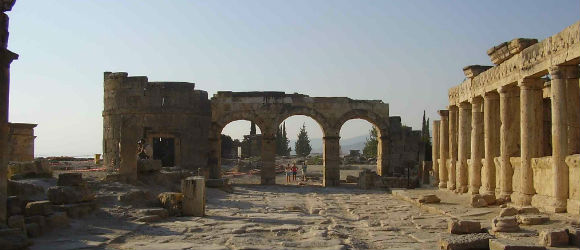The presence of a hot spring at Hierapolis and the spectacular calcium deposits from its water spilling over the nearby hillside suggest that there should be evidence of an early settlement there. The oldest Inscription found so far, however, indicates it was founded by Eumenes II, king of Pergamon, in the latter part of the second century B.C.; it soon became a busy industrial center.
Pagan worship in the city centered around Cybele, Apollo, Artemis, Men, Poseidon, and Pluto. Underneath the Temple of Apollo has been found the Plutonium, an opening in the earth from which a noxious gas still comes. The temple is between the pool where the hot spring rises and the large theater on the side of the hill. To the north along the rim of the plateau is a long avenue of tombs.
Traditionally St. Philip is connected with the early church in Hierapolis. Fairly recently Italian archeologlsts have discovered his Martyrium, an octagonal chamber forming a double cross surrounded by a square. This is almost due north of the theater, also on the side of the hill. It was a fifth century A.D. building and did not last much more than 100 years. No tomb was found with it although that was expected. There are several ruins of churches, one not far from the baths, one on the main road leading to the necropolis.
Hierapolis is listed in the New Testament along with Laodicea as the center of Epaphras’s work (Colos-sians 4:13). This was at the time Paul was writing to strengthen the message Epaphras was preaching and to condemn the “people who go in for self-mortification and angel-worship” (Colossians 2:18). Another less well-known resident of Hierapolis was Papias, a disciple of St. John and the author of the lost book called the Sayings of Jesus.
While Epaphras was is that area, a young slave was growing up in Hierapolis, a boy whose original name is unknown but whom we call by the Greek for “Acquired”, Epictetus. In his Discourses Epictetus often talks about the perfect missionary whose bed was the ground, whose only house the earth and sky and a shabby cloak, and who must love those who misuse him in the service of God. One wonders what the influence of those early Christians, many of whom were slaves themselves, was on this Stoic philosopher.
Hierapolis,


The ancient greek spa-town is a terrific and very well preserved historical site. The Roman amphitheater, about a kilometer of the castles of "cotton" (travertine limestone natural attraction), is the leader among the monuments in ruins.
Pamukkale was fantastic, we really enjoyed our day, although it was SO hot. I wouldn't recommend paying the 30 lira to swim in the 'antique' pool. If you keep walking down the terraces, you can enjoy the water.
The entrance combines both sites, so you cannot visit one without the other. I was amazed at the size and scale of this former city. There is still a lot of restoration work going on, including main theatre. The large yellow crane used next to the theatre was a bit distracting, but you could avoid it in photographs by picking…
Aside from the historical and environmental awesomeness you get to see all of that from up high. I really do recommend flying with "Pamukkale Paragliding". Their staff is pretty friendly and helpful and Pilots are well equipped and experienced. I got a little bit nervous before the take-off and they managed to calm me down (= Flying there feels like…
The calcium carbonate fields/falls are beautiful to see. Playing in the hotsprings was fun. We then toured the ruins of Hieropolis and walked back by way of the Necropolis. The calcium carbonate is used to make tiles. (Travertine). I recently installed some in a bathroom, and they very well may have come from there.
very unique attraction, with the geological formations here, and natural hot springs. Quite spread out, on a plateau overlooking a vast valley. Wonderful place for a day trip, and long stroll thru Roman ruins.
Unique place to visit – must see. Glad Turkey is finally looking after their heritage and all the beautiful places there are to see there
30 years ago the natural pools at Pamukkale were like sitting in a warm pool cocooned in a cloud and feeling a godlike ownership over the marvellous views over the valley.
I was expecting many more people but not the manmade changes to a natural landscape. The manmade pools do allow you to dip in the warm waters and feel…
A beautiful place where you feel transported to the past. Do not miss it!
Beautiful, but a little crowded! don't go to the pool in Hierapolis , it's a tourist trap, stay in the basins and see the beautiful ruins, don't waste your time in the pool with hundreds of people.